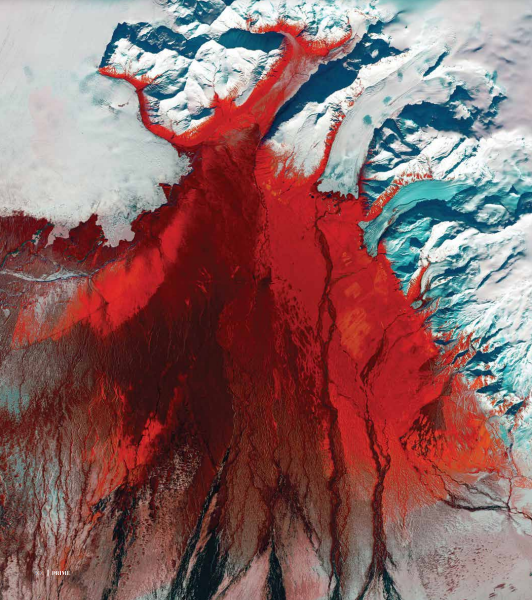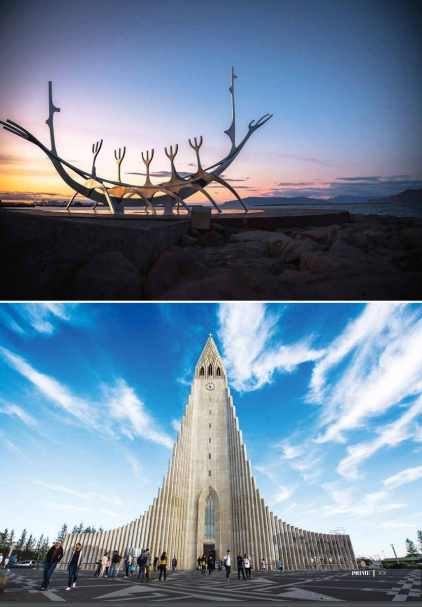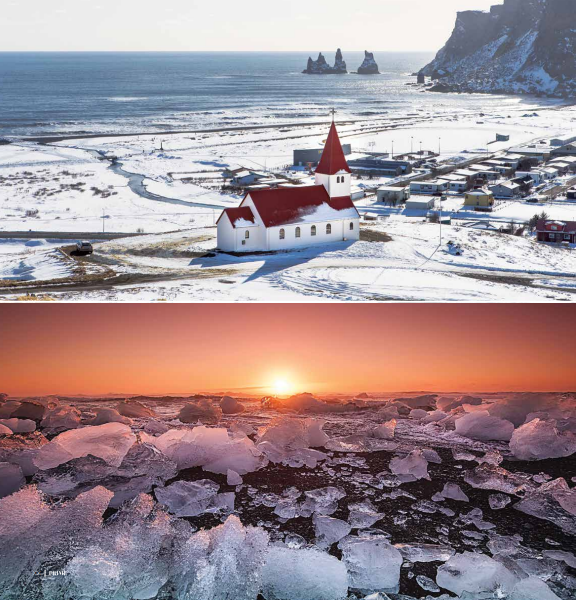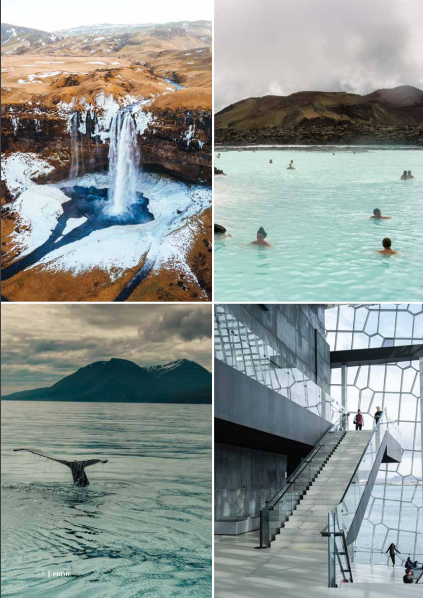Fire & Ice
Exploring Iceland Without Breaking Your Budget

I celand is a land of mystique. It is the land of sheep, Northern Lights, volcanoes, craters, rugged landscapes, waterfalls, glaciers, mountains, black sand beaches and natural hot springs. For a tiny island only 103,000 km² in size, it has an extremely diverse and beautiful landscape. It is a nature lover’s paradise. But why is it nicknamed the Land of Fire and Ice? And, how can you experience the wonders of Iceland when you visit this magical country?
LAND OF FIRE AND ICE
Iceland sits in the middle of two tectonic plates: North American and Eurasian. The west of Iceland sits on the North American plate (e.g. Reykjavík and Snæfellsnes Peninsula), while the east sits on the Eurasian plate. This means that Iceland is sitting on a constant source of friction with the movement of two major tectonic plates beneath. As a result, volcanism is a major part of the Icelandic landscape, hence the “fire” part of the nickname. The “ice” part of the moniker comes from Iceland’s 269 glaciers that cover roughly 11% of the whole country. Glaciers have formed in locations where the mean and average annual temperatures sit below 0°C and where winter precipitation in the form of snow surpasses summer melt (e.g. where it snows in the summer months as well).
GETTING TO AND AROUND ICELAND
All international flights to/from Iceland land at Keflavík International Airport, which is a 40-minute drive from the Icelandic capital, Reykjavík. Travellers can take the Flybus airport shuttle to Reykjavík Bus Terminal in the capital city centre for US$28 (~S$38) or the Airport Direct Economy to the same destination for 3,290 ISK (~S$36). There is also an Airport Direct Premium option at 6,590 ISK (~S$72). An even more economical option is to take the public bus service, Strætó, which only costs around 480 ISK (~S$5). However, you will need to ask around and find out the relevant service routes to take to your accommodation. Beyond coaches, Flybus and Airport Direct also operate private transfer services. Cabs also frequent the route between the airport and downtown Reykjavík. These will cost you about 15,000 ISK (~S$165) one way.
If you are planning to go beyond Reykjavík, driving is your best option for exploring the rest of Iceland. There are major international car rental companies like Hertz, Budget and Avis operating out of Keflavík International Airport. Travellers may also consider Bílaleiga Akureyrar, the largest car rental company in Iceland.
If you choose to drive, take note that you will be driving on the right side of the road in Iceland (as opposed to the left in Singapore) and the speed limit is expressed in kilometres. The price of petrol in Iceland is about the same as Singapore. On average, one litre costs about 235ISK (~S$2.50). Regardless of the time of year, travellers should spend more for a sturdy vehicle with four- or all-wheel drive. While the winter brings ice and snow (and the need for studded snow tires), summer can bring sandstorms. Drivers should be aware that, year-round, the wind can be incredibly forceful.
If you do not want (or know how) to drive, you can also explore Iceland using buses. For this option, look no further than the main bus service company in Iceland: Reykjavík Excursions. Reykjavík Excursions offer a great selection of tours as well as point-to-point scheduled services for different destinations and preferences. They also offer a tailor-made option for travellers to customise their tours.
REYKJAVÍK
As the landing point for international travellers, Reykjavík is the place to start when exploring Iceland. You may wish to start with the magnificent Hallgrímskirkja Church. The most prominent landmark in Reykjavík’s city’s centre, Hallgrímskirkja can be seen from almost anywhere in Reykjavík. It is an easy place to navigate and should be one of your first stops. The national monument is as stunning on the inside as it is on the outside. Built as a tribute to Icelandic poet, Hallgrimur Petursson, the magnificent 25- ton pipe organ inside the church is one of its most notable features. You can also ride the elevator up almost 74m to the steeple to get an unobstructed view of the city.
Another place that you may want to explore in Reykjavík is the Harpa concert hall. This extraordinary landmark’s awardwinning architecture is uniquely artistic. The honeycomb exterior is eye-catching in the daylight and mesmerizing at night as the windows change in a rainbow of colours. If you can catch a concert in Harpa, plan on extra time before or after the performance to enjoy dinner at either of the two restaurants inside serving authentic Icelandic food, and take a stroll by the water around the venue.
Iceland is a land that, in many ways, is defined by water. Thus, what better way to connect to Icelandic culture than visiting one of Reykjavík’s many pools. Thanks to Iceland’s renewable energy policies, the use of water in large capacities, such as swimming pools and saunas, is very cheap. This makes it a favourite pastime amongst many Icelanders. There are 18 swimming pools located in the greater Reykjavík area alone. Some of these locations have indoor and outdoor pools, a sauna, and at least one hot tub. The pools have heated water, making them accessible all year round. So think of Icelandic swimming pools as more like a luxury spa than your average sports complex swimming pool. Furthermore, for the entry price of only 1,030 ISK (~S$11), this might be one of the cheapest spas you will ever come across.
While in Reykjavík, you may also wish to take some time to explore downtown Reykjavík by foot. It is unlike most downtowns in other countries. Instead of kitschy souvenir shops, you will find independent boutiques selling unique items, like Icelandic wool clothing and volcanic rock pottery. Take your time to enjoy the shops and fine eateries serving up traditional fare.
Let your stroll take you to the waterfront walkway to feel the ocean breeze, and observe the fine art and architecture in the city. In the late afternoon, position yourself near the waterfront Solfar sculpture to enjoy one of the most majestic sunsets you will see in Iceland. If you are a drinker, you may also wish to stay up late (past midnight) to explore the city’s bar scene. While alcohol prices may be high, Reykjavík has been touted as one of the best places in the world to go out. The nightspots are confined to 101, in the city centre, and are nearly all intimate bars with special motifs and themes.
Other attractions that you may wish to visit in Reykjavík include the Sun Voyager, an abstract stainless steel sculpture of a ship that was erected in 1990 to commemorate the city’s 200th anniversary; the highly unusual Icelandic Phallological Museum, a museum dedicated to the penis, housing the world’s largest collection of animal penises and phallic memorabilia; and the Old Harbour Area, a section of the city that has some of the best views of the Faxaflói Bay (facing Reykjavík), and the departure point for whale watching tours and puffin excursions. If you want a guided tour, go for the free City Walk Reykjavík. The famous two hour walking tour focuses on the history of Iceland, the evolution of Reykjavík as a town and Icelandic culture in general, laid out in an informative and comic way.
For accommodation in Reykjavík, if you do not mind staying in hostels, pay a visit to Hey Iceland (HI), an award winning Icelandic travel agency with over 30 years of knowledge and expertise in travel. Most hostels in the country are in the HI network. For budget travellers, the conveniently located Kex Hostel is a good starting point. Kex Hostel has dormitories or private rooms, and offers easy access to Reykjavik’s best sightseeing areas. Staff are available 24/7, and can help with booking tours and tickets.
If you have set aside more money for accommodation, there are also other mid-tier, family-friendly and higher end hotels to consider in Reykjavík. A good mid-tier range of hotels to consider are the Radisson hotels: Radisson Blu 1919 Hotel and Radisson Blu Saga Hotel. For the luxury traveller, the historic Hotel Borg, opened in 1930 (and renovated in 2015) with an Art Deco feel in the rooms, and the Canopy by Hilton Reykjavík City Centre, located in the heart of the city at Hverfisgata should be seriously considered.
NORTHERN LIGHTS
Iceland is one of the best places in the world to see the aurora borealis, better known as the Northern Lights. Here, at 65°N on the southern edge of the Arctic Circle, you can see auroras almost every night. The Northern Lights are caused by electrically charged particles from the sun smashing into Earth’s magnetic field. This “solar wind” is funnelled down to the magnetic poles of the Northern and Southern Hemispheres, creating a horseshoe shape of excited green, red and blue particles that swivel and shapeshift over the Arctic Circle. This happens constantly. All you need is darkness (no light pollution) and cloud-free skies to see them. And it is very easy to get to a dark place in the Land of Fire and Ice. Witnessing this wonderful natural phenomenon is likely to be one of the most awe-inspiring sights you will ever see. The best time to catch them is from mid-September to mid-April.
While it is actually possible to see the Northern Lights from Reykjavík (if they are intense enough), it is wiser to plan at least a short drive away from the city to maximize your chances. The beautiful Þingvellir National Park is a popular place to go to from Reykjavík, though the Reykjanes Peninsula surrounding the capital city is also a great place to witness this natural phenomenon. Other places which you can visit to see the Northern Lights in their full glory include Hella, where you can book yourself into Hotel Ranga, which has an aurora alert service and outdoor hot tubs, as well as an on-site observatory with astronomers on hand to help you take full advantage of any clear skies; Skógar, where the mighty Skógafoss waterfall is located; Snæfellsnes Peninsula, a few hours’ drive away from Reykjavík that has excellent wilderness accommodation, including the upscale Hotel Búdir and the more affordable Guesthouse Hof; and the Jökulsárlón glacial lagoon.


GOLDEN CIRCLE TOUR
The Golden Circle is an essential excursion for all travellers to Iceland. It is a 250km tourist route to see some of Iceland’s most iconic sites. Its three incredible locations – the Geysir Hot Spring Area, Gullfoss Falls and Þingvellir National Park, which is the only UNESCO World Heritage Site on Iceland’s mainland – are among the nation’s most popular spots. Most visitors plan a full day exploring these areas, before setting off on the rest of their travels.
The Geysir Hot Spring Area has such explosive geysers that the name of the largest geyser became known as “The Great Geysir.” Although the Great Geysir is now virtually dormant, its neighbor Strokkur still erupts every five minutes or so, to heights of over twenty metres. On the other hand, Gullfoss is the best-known waterfall in Iceland. It surges with enormous power down two tiers into an ancient valley carved out in the last ice age. Those who visit on a sunny day will be delighted by the rainbows slicing through the mist here. Finally, Þingvellir National Park is located in an incredible valley between the North American and Eurasian tectonic plates. It boasts a spectacular landscape of lava fields and forests, interrupted with crystal clear streams.
There are plenty of Golden Circle guided tours as well as several worthy detours from the route that you can visit if you have enough time. Due to these sites’ popularity, many tour operators offer additional fun activities to their sightseeing itinerary. Qualified snorkelers or divers can snorkel or dive in one of Þingvellir’s freshwater springs, Silfra, for some of the best underwater sights in the world. The adventurous can even add a snowmobiling trip to their itinerary, which leaves from Gullfoss and takes you onto the surface of the mighty Langjökull glacier.
Many hotels and hostels have developed in these areas so that visitors can use the Golden Circle as a springboard to travel elsewhere and do not need to return to Reykjavík to spend the night. At Geysir, for example, you can stay at the Litli Geysir Hotel, while Gullfoss offers the cosy, competitively priced Hótel Gullfoss. Borealis Hotel, located right beside Þingvellir, has several different types of accommodation to choose from, including standard rooms, two-bedroom bungalows and spacious, three-bedroom villas.
WHALE WATCHING IN HÚSAVÍK
Iceland’s waters is known to be a top destination for whale-watching. Here, you can find over twenty whale, dolphin and porpoise species. While boat tours do head out from ports such as Reykjavík and Akureyri (the second largest city in Iceland, up in the north), in places such as the Westfjords, you can actually catch sight of whales from shore. However, the most successful tours typically set out from the small northern town of Húsavík.
Húsavik is often nicknamed “the whale watching capital of Europe.” It sits by Skjálfandi Bay, which teems with aquatic life throughout the summer. You can spot harbour porpoises, white-beaked dolphins and humpback whales almost every day. Occasionally, if you are lucky, you may also see more unusual species such as orcas, blue whales, fin whales and even disoriented narwhals. Summer is also the nesting season for many migratory bird species in Iceland, most notably the puffin. You can spot these birds on whalewatching tours from Reykjavík, Akureyri and Húsavík. Specific trips may even include a visit to the puffins’ nesting grounds.

LAKE MÝVATN
Around an hour’s drive from Akureyri, Lake Mývatn is a geological and geothermal wonderland. Formed by a streak of catastrophic eruptions over two millennia ago, the area boasts a series of beautiful lakes teeming with life. There are dozens of bird species that flock to these waters in the summer, and those with an interest in flora should look out for moss balls, which form in few other places around the world.
The geology that surrounds Mývatn is perhaps even more spectacular. Perfectly formed pseudo-volcanic craters line many banks. You can walk up to and around them and discover the secrets of Iceland’s volcanism. Dimmuborgir is a field of lava so dramatic, it is often called the Black Fortress. Within this lava field, hidden in a cave, is the increasingly famousGrjótagjá hot spring. This is a must-visit spot for fans of the Game of Thrones TV series as the cave was featured in one of the franchise’s most famous love scenes. However, do take note that you cannot bathe in the water here due to its ever-changing temperature. If you want to bathe in geothermal waters, the Mývatn Nature Baths are a perfect place to unwind. To visit the Mývatn area, book your tour through a local tour company.
SELF-DRIVING THE RING ROAD
Self-drive tours offer the best flexibility for your trip. You will be able to customise your experience and change plans when needed, based on the ever-changing weather patterns. This way, you can also allocate more time to the places you think you will enjoy.
Iceland has one main road: Route 1 AKA the Icelandic Ring Road. This ring road goes all around the island and is 1,332km long, allowing visitors to see all regions of the island, bar the Westfjords and Snæfellsnes Peninsula. Perhaps, most importantly, the road connects Reykjavík in the south to Akureyri in the north. Engaging in a selfdrive trip allows you to take in all the diverse landscapes and sights that Iceland has to offer in between these two major cities.
For example, the Snæfellsness Peninsula can be easily covered in two days using the ring road. Other popular tourist attractions that you can access using the ring road include the Seljalandsfoss and Skógafoss waterfalls; the Mýrdalsjökull and Eyjafjallajökull glaciers; the blacksand-beach of Reynisfjara; the Jökulsárlón glacier lagoon; Hallormsstaðaskógur, the largest forest in Iceland; the Lagarfljót lake; Lake Mývatn; and Goðafoss waterfall. There are also many other historical settlements and sites that you can take in, such as the Black Church of Budir.
HIKING THE TRAILS
If you are feeling adventurous, you can try to head out to the Laugavegur Trail. This 55km trail that runs between Landmannalaugar and Þórsmörk in southern Iceland is a popular destination for locals and foreign visitors. It remains one of the most extraordinary walking trails in the world. The Laugavegur Trail offers sights and experiences of a great variety of landscapes: mountains in various colours, hot springs and glaciers, rivers, and lakes. Its well-worn treads, cozy huts, a steady stream of trekkers and frequent wood marking posts make it a relatively safe and logistically easy venture. You can stay in huts for about 4,600 ISK (~S$50) per night, or camp in the designated areas outside the huts for a mere 1,200 ISK (~S$13) per night.
If 55km proves too daunting, try your hand at the shorter, but equally stunning Fimmvörðuháls Trail. Stretching between Þórsmörk and Skógar, this trail can be done in a day or broken up into a two-day adventure. You can either camp or book one of the mountain huts located along the route for an overnight stay. Just be aware: the huts sell out fast!
ICELANDIC FOOD
Traditionally, living in a place as remote as Iceland, Icelanders have had to make do with eating what was around them. This has led to some curious dishes that our taste buds may not get accustomed to. If you are feeling adventurous and would like to find out what the locals indulge in, you may want to start with some of the more “conventional” dishes.
Hangikjöt would be a good dish to start. This traditional festive dish consists of smoked lamb, mutton or horse meat boiled and served either hot or cold in slices, traditionally with potatoes in béchamel sauce and green peas, or in thin slices on bread. There are several types of hangikjöt and the meat can come from various parts of the sheep, but the most common are the hind legs. Skyr, an Icelandic cultured dairy product, has the consistency of Greek yogurt, but with a milder flavor. It is another excellent choice for the less adventurous among us. Skyr has been a part of Icelandic cuisine for centuries. It has a slightly sour dairy flavour, with a hint of residual sweetness, and is traditionally served cold with milk and a topping of sugar.
For more adventurous connoisseurs, you can try Hákarl, cubes of fermented shark meat with a disturbingly strong taste. It has a strong ammonia-rich smell and fishy taste, and can be an acquired taste. If you have a weak stomach, it may be prudent to tick this off the must-try list. Similarly, other local dishes such as Þorramatur, pickled meat and fish products cut and served in slices or pieces, and Svið, a traditional Icelandic dish consisting of a sheep’s head cut in half and boiled with the brain removed, may not be the most easily palatable dishes. Approach at your own risk!
UNIQUE AND EXCLUSIVE EXPERIENCE
Iceland, the Land of Fire and Ice, remains one of the most fascinating destinations that anyone is likely to visit. It will also, possibly, be one of the most beautifully and naturally immersing visits you will ever make. If you have always wanted to go to Europe, but want to go off the beaten trail and visit an unusual location, there is no more unique and exclusive place to experience than Iceland, even if it is not the cheapest place to hit. So what are you waiting for? Start saving up now to visit the Land of Fire and Ice!










